Understanding Your Automobile'S Caution Lighting: What Do They Truly Mean?
Understanding Your Automobile'S Caution Lighting: What Do They Truly Mean?
Blog Article
Authored By-Termansen Kejser
When you're behind the wheel, those radiant caution lights on your control panel can be a bit bewildering. Do you understand what they're attempting to inform you about your cars and truck's wellness? Comprehending the importance of these lights is important for your safety and security and the longevity of your automobile. So, the following time among those lights appears, wouldn't you intend to understand its message precisely and take the necessary steps to resolve it?
Common Caution Lighting and Interpretations
Identify common warning lights in your auto and comprehend their definitions to ensure secure driving.
The most common warning lights include the check engine light, which indicates concerns with the engine or discharges system. If this light begins, it's vital to have your lorry inspected quickly.
The oil stress alerting light suggests low oil pressure, requiring instant attention to stop engine damages.
A blinking battery light could suggest a malfunctioning billing system, possibly leaving you stranded otherwise attended to.
https://www.moneytalksnews.com/slideshows/17-summer-water-saving-tips-to-reduce-your-bill/ (TPMS) light informs you to low tire stress, impacting automobile stability and gas effectiveness. Disregarding this could result in harmful driving problems.
The abdominal muscle light suggests an issue with the anti-lock braking system, endangering your capability to quit rapidly in emergencies.
Last but not least, the coolant temperature warning light warns of engine getting too hot, which can result in extreme damage if not solved swiftly.
Recognizing these common warning lights will help you deal with issues promptly and maintain secure driving problems.
Relevance of Prompt Interest
Recognizing the typical warning lights in your vehicle is just the initial step; the significance of immediately addressing these warnings can't be emphasized sufficient to guarantee your safety and security when traveling.
When a caution light illuminates on your control panel, it's your auto's method of communicating a potential concern that requires focus. Overlooking cardetailingspecialistauckland can bring about more severe problems down the road, compromising your security and possibly costing you much more in repairs.
Motivate interest to advising lights can protect against breakdowns and crashes. For instance, a flashing check engine light could suggest a misfire that, if left unattended, could trigger damage to the catalytic converter. Resolving this without delay can conserve you from a costly repair.
In just click the next article , a brake system warning light might signify low brake fluid or used brake pads, crucial elements for your safety when driving.
DIY Troubleshooting Tips
If you see a caution light on your dashboard, there are a few DIY troubleshooting pointers you can try before looking for specialist assistance.
The first step is to consult your car's manual to recognize what the certain warning light indicates. Occasionally the issue can be as basic as a loosened gas cap causing the check engine light. Tightening up the gas cap might fix the issue.
An additional usual issue is a reduced battery, which can activate various advising lights. Inspecting the battery connections for rust and ensuring they're safe and secure may fix the problem.
If a caution light persists, you can attempt resetting it by disconnecting the cars and truck's battery for a few minutes and then reconnecting it. Furthermore, inspecting your automobile's fluid degrees, such as oil, coolant, and brake fluid, can assist fix advising lights associated with these systems.
Conclusion
In conclusion, comprehending your vehicle's caution lights is essential for maintaining your automobile running smoothly and securely. By promptly resolving these signals and recognizing what they mean, you can prevent costly repair work and potential failures.
Remember to consult your automobile's guidebook for specific information on each cautioning light and do something about it accordingly to ensure a trouble-free driving experience.
Keep educated, remain secure when driving!
